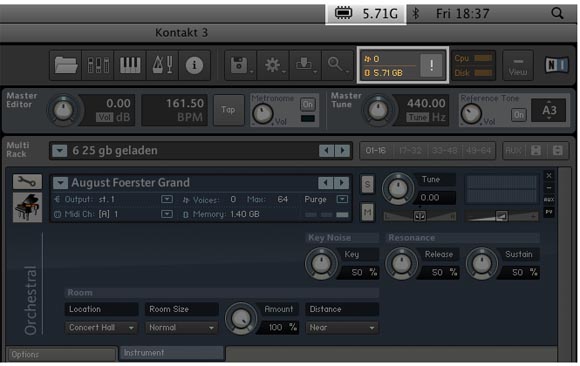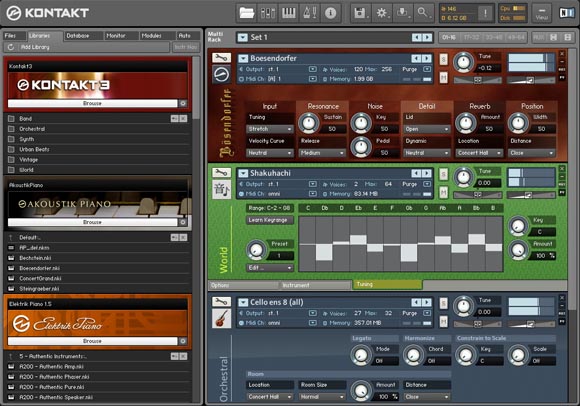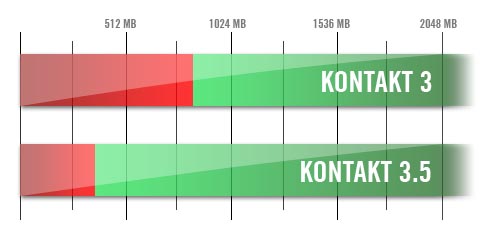
Native Instruments has updated its sampling engine, releasing beta versions 3.0.5 for its Battery drum sampler and 3.5.0 final for the flagship Kontakt sampler. Both are free upgrades. (For anyone who thought that somehow Maschine was replacing Battery, it isn’t: the former is a drum machine, whereas the latter is more like a high-end drum sampler.)
There are a number of significant enhancements, but perhaps the most interesting is the support for 64-bit memory addressing. On 64-bit Windows Vista (and upcoming 64-bit Windows 7), that gives you true 64-bit memory addressing for — well, more memory than you have. (The theoretical limit of Windows’ 64-bit architecture on Intel is 16 terabytes.) This allows native 64-bit memory addressing on Windows for both Battery and Kontakt.
The Mac isn’t quite capable of that just yet (at least no audio applications beyond Apple’s own developer tools support 64-bit memory addressing yet), but the Kontakt Memory Server gives you up to 32 GB on 10.4 and later. Clarification: The Kontakt Memory Server is available now only for Kontakt.
The other important development for both Battery and Kontakt is that compatibility with Pro Tools 8 under Mac OS 10.5 Leopard has been restored.
Getting Kontakt on 64-bit is a very big deal, because of the widespread popularity of the sampler. At the same time, the fact that it’s not alone is a good thing — it suggests 64-bit memory for samplers may be catching on. Steinberg’s HALion, Cakewalk’s Dimension Pro, Garritan’s ARIA, and the open source Linux Sampler Project are some of the more familiar samplers that have gone 64-bit recently. (Note that, despite its name, Linux Sampler can run 64-bit on both Linux and Windows.) Cakewalk did a lot to lead the way here on Windows by getting both its SONAR host and Dimension Pro (among other plug-ins) fully 64-bit early. Garritan is equally interesting, because their Plogue-based engine is getting licensed out to soundware makers and, architecturally, is built more as a cross-platform engine. Garritan ARIA is also targeting Linux, and Cakewalk and Garritan are also supporting the open SFZ format.
Okay, I should have put that in a table. Imagine a table in your mind. Wow, that looks beautiful.

What else is new in Kontakt
64-bit is the headline, but there are other enhancements, too, in the Kontakt engine:
- “Zero-memory” DFD means you use less memory when streaming from disk (and using less memory is usually the very reason you’re streaming from disk)!
- True multiprocessor/multi-core support for enhanced performance
- A virtual rack of all your installed libraries and third-party content, so it’s easier to find your sounds
- Direct MIDI learn (meaning everything is finally assignable), improved automapping, bypass for effects slots
- Pro Tools compatibility now works properly on Mac Leopard
- KSP aftertouch interpretation – so now you can do something with that aftertouch-transmitting keyboard of yours
Update: Note that these are Kontakt-specific features, and not relevant to Battery for reasons clarified below.

Battery vs. Kontakt
Updated: You will note that Native Instruments is updating Battery and Kontakt more or less at the same time, and they do share some core technologies that allow that to happen. They aren’t exactly the same under the hood, though, as NI explains to CDM:
The core engine technology is the same in Battery 3.0.5 and Kontakt 3.5, but Battery uses a “lighter” version because of its typical use case as a drum sampler.
It doesn’t include the Memory Server and the multiprocessor/multicore support because these features really only become necessary with multitimbral operation, high polyphony and a huge number of instrument samples (and heavy effects usage) like in Kontakt.
Let us know what you think if you’re a Kontakt/Battery user.
New features in Kontakt 3.5 versus 3.0 [Native Instruments]
Public beta of Battery 3.0.5 [at the NI public beta site]
